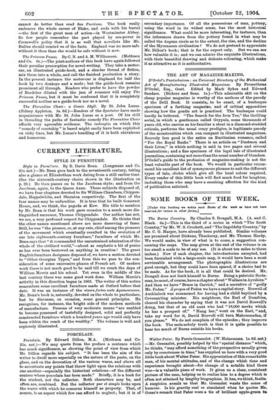STYLE IN FURNITURE.
Style in Furniture. By R. Davis Benn. (Longman and Co. 21s. net.)—Mr. Benn goes back to the seventeenth century, taking also a glance at Elizabethan work dating from a still earlier time. (See the sixteenth-century chairs shown in the illustration on p. 29.) He then passes on to the Jacobean style; and from the Jacobean, again, to the Queen Anne. These subjects disposed of, we have four chapters devoted to Sir William Chambers, Chippen- dale, Heppelwhite, and Sheraton respectively. The first of the four names may be unfamiliar. It is true that he built Somerset House, and, we think, the pagoda at Kew. His title to mention by Mr. Benn is that his work gave occasion to a much more dis- tinguished successor, Thomas Chippendale. Our author has not, we see, a very profound respect for Chippendale. He thinks that the other names mentioned above are more deserving of fame. Still, he was "the pioneer, or, at any rate, chief among the pioneers of the movement which eventually resulted in the evolution of our late eighteenth-century furniture," furniture of which Mr. Beim says that " it commanded the unrestrained admiration of the whole of the civilised world,"—about as emphatic a bit of praise as has ever been bestowed on anything in creation ! The great English furniture designers disposed of, we have a section devoted to " Other Georgian Types," and from this we pass to the con- sideration of some successive phases of French art. Of modern work there is not much good to be said till we reach the days of William Morris and his school. Yet even in the middle of the last century there was some good work done. William Morris's activity in this direction began in 1863. The writer of this notice remembers some excellent furniture made at Oxford before that date. It was an instance of the vizere fortes ante Agamemnona. Mr. Benn's book is, naturally, devoted on the whole to particulars, but he discusses, on occasion, some general principles. He recognises, for instance, the bright side of the modern methods of manufacture. Persons of very moderate means "are enabled to become possessed of tastefully designed, solid and perfectly constructed furniture which a hundred years ago would only have been within the reach of the wealthy." The volume is well and copiously illustrated.
PORCELAIN.










































 Previous page
Previous page